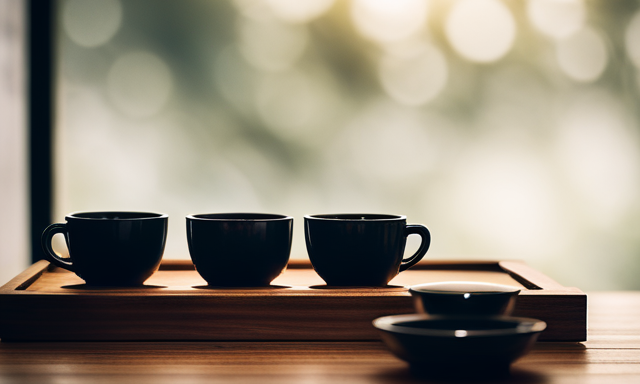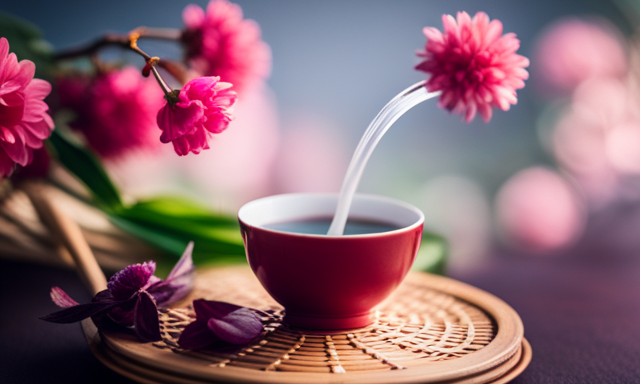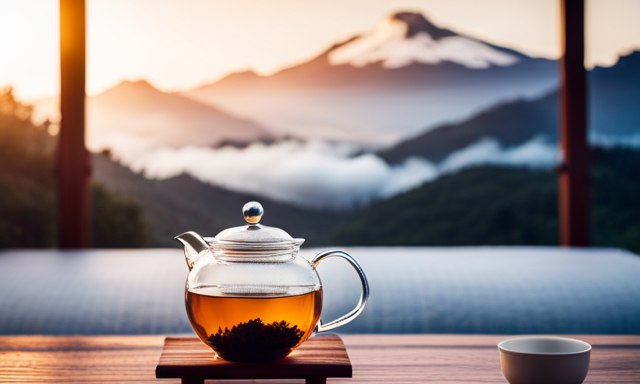When it comes to tea, there’s a vast world of choices to explore. But two varieties that often leave people in a state of perplexity are oolong tea and white tea. Both have their unique qualities and flavors, making it difficult to decide which one to sip on.
That’s where I come in. In this article, I’ll delve into the depths of these two teas, unraveling their mysteries and shedding light on their differences.
Oolong tea, with its rich and complex taste, stands in stark contrast to the delicate and subtle flavors of white tea. As a tea enthusiast, I’ve had the pleasure of exploring the production methods, caffeine content, taste profiles, health benefits, brewing techniques, cultivation, and harvesting of both teas.
By the end of this article, you’ll have a comprehensive understanding of oolong tea and white tea, allowing you to choose the perfect cuppa for yourself. So, grab a seat, brew yourself a warm cup, and let’s embark on this flavorful journey together.
Key Takeaways
- Oolong tea offers complex flavors and a range of oxidation levels.
- White tea is known for its delicate flavors and is hand-picked in early spring.
- Fujian province in China is the main producer of both oolong and white tea.
- When choosing between oolong and white tea, consider preferred brewing methods and flavor preferences.
Production Methods
So, let me tell you about how oolong tea and white tea are made. Both types of tea go through different production methods, resulting in unique flavors and characteristics.
Oolong tea is partially oxidized, while white tea is minimally processed, making it the least processed tea among all types. Oolong tea leaves are withered, rolled, and then oxidized to a specific level, giving it a distinct taste and aroma. On the other hand, white tea leaves are simply picked and dried, preserving their natural flavor and delicate aroma.
When it comes to caffeine levels, oolong tea generally contains more caffeine than white tea. As for brewing methods, oolong tea is often steeped multiple times, while white tea is typically brewed with lower temperature water for a shorter duration.
Now, let’s move on to the next section and discuss the caffeine content of these teas.
Caffeine Content
However, the caffeine content in oolong tea differs from that in white tea. While both types of tea contain caffeine, the brewing methods play a significant role in determining the actual amount of caffeine in the final cup.
Oolong tea is typically brewed using higher water temperatures and longer steeping times compared to white tea, which results in a higher caffeine content. On the other hand, white tea is often brewed at lower temperatures and for shorter durations, leading to a lower caffeine content.
It’s important to note that individual caffeine sensitivity can also influence how the body reacts to the caffeine in these teas.
Now, let’s dive into the next section about the taste profiles of oolong tea and white tea.
Taste Profiles
When it comes to flavor, oolong and white tea dance on the taste buds like a symphony of delicate and robust notes. Oolong tea offers a complex flavor profile that ranges from fruity and floral to woody and nutty. It can be brewed to bring out different flavors, making it a versatile choice for tea enthusiasts.
On the other hand, white tea has a subtle and delicate taste with hints of sweetness and floral undertones. It is often described as light and refreshing, making it a popular choice for those who prefer a milder tea experience. Both teas can be brewed using different methods, such as steeping in hot water or cold brewing, to enhance their unique flavors.
Now, let’s transition to the next section and explore the health benefits of oolong and white tea.
Health Benefits
Oolong tea has been suggested to have potential weight management properties due to its natural compounds that may help boost metabolism and aid in fat burning. Research has shown that oolong tea can help increase energy expenditure and fat oxidation, making it a possible ally in weight management efforts.
On the other hand, white tea is known for its high antioxidant content, which can help protect the body against free radicals and oxidative stress. Antioxidants in white tea have been linked to various health benefits, including a reduced risk of chronic diseases such as heart disease and certain types of cancer.
Oolong tea’s potential weight management properties
Furthermore, its potential weight management properties make oolong tea a fascinating option for those looking to enhance their fitness journey. Oolong tea has been shown to have a positive impact on metabolism, helping to increase fat oxidation and promote weight loss.
In addition to its metabolism-boosting effects, oolong tea also contains polyphenols that can help reduce inflammation in the body. This can be particularly beneficial for individuals who’re trying to lose weight, as chronic inflammation has been linked to obesity and metabolic disorders.
By incorporating oolong tea into your daily routine, you can potentially improve your body’s ability to burn fat and support your weight loss goals.
Moving on to white tea’s high antioxidant content…
White tea’s high antioxidant content
White tea, with its high antioxidant content, offers a powerful boost to your overall health and well-being. Antioxidants play a crucial role in preventing chronic diseases by neutralizing harmful free radicals in the body.
The abundance of antioxidants in white tea can help reduce the risk of various illnesses, including heart disease and certain types of cancer. Additionally, the antioxidants in white tea can have a positive impact on skin health, promoting a youthful complexion and protecting against oxidative stress.
To fully benefit from white tea’s antioxidant properties, it’s important to brew it correctly. By mastering the proper brewing techniques, you can ensure that you extract the maximum amount of antioxidants and other beneficial compounds from the tea leaves.
Brewing Techniques
To enhance your tea experience, try experimenting with different brewing techniques for oolong and white tea.
When it comes to brewing temperature, oolong tea is best brewed at around 190-200°F, while white tea requires a lower temperature of 160-170°F.
Steeping time is also crucial for extracting the best flavors. For oolong tea, a shorter steeping time of 2-4 minutes is recommended to prevent bitterness. On the other hand, white tea benefits from a longer steeping time of 4-6 minutes to fully release its delicate flavors.
To create a perfect cup of oolong or white tea, follow these steps:
- Start by heating the water to the appropriate temperature.
- Add the tea leaves to a teapot or infuser.
- Pour the hot water over the leaves and let them steep for the recommended time.
- Finally, strain the tea and enjoy its unique taste.
Now that we’ve covered brewing techniques, let’s dive into the intriguing origin and history of oolong and white tea.
Origin and History
Oolong tea has its origins in China, where it has been cultivated and enjoyed for centuries. It is a unique tea that falls between green and black tea in terms of oxidation, resulting in a complex and nuanced flavor profile.
On the other hand, white tea holds historical significance in Fujian province, known for its delicate and subtle flavors. It’s made from the youngest leaves and buds of the tea plant, and its production methods have been passed down through generations.
Oolong tea’s origins in China
Originating in the lush mountains of China, oolong tea is a true gem, steeped in a rich history and cultural heritage. Its popularity in the West has soared in recent years, thanks to its unique flavor profile and numerous health benefits.
When compared to other Chinese teas, oolong stands out with its semi-oxidized leaves, which give it a distinct taste and aroma. The process of making oolong tea involves meticulous craftsmanship and expertise, resulting in a beverage that is both complex and satisfying.
As we delve further into the world of Chinese teas, it’s fascinating to explore the origins of white tea in Fujian Province. This region holds a significant place in history, as it was the birthplace of white tea and continues to produce some of the finest varieties known to tea connoisseurs.
White tea’s historical significance in Fujian province
After exploring the origins of Oolong tea in China, it’s fascinating to delve into the historical significance of white tea in Fujian province.
This delicate and mild tea has been cherished for centuries, with records dating back to the Tang dynasty. Fujian, known for its lush mountains and misty climate, provides the perfect conditions for white tea cultivation.
In the historical context of Fujian, white tea gained prominence as a prized tribute tea during the Song dynasty. Emperors and nobles revered it for its subtle flavor and health benefits.
Today, Fujian remains the main producer of white tea, with its rich tea heritage attracting tea enthusiasts from around the world.
Nestled among the rolling hills and ancient tea gardens, Fujian province continues to preserve the tradition of white tea production, ensuring that its historical significance endures.
Moving forward, let’s explore the fascinating process of cultivation and harvesting in the world of white tea.
Cultivation and Harvesting
During cultivation and harvesting, you’ll be amazed by the meticulous care that goes into producing these teas. Cultivation techniques for white tea involve growing the Camellia sinensis plant in the Fujian province of China. The tea plants are carefully tended to ensure optimal growth and flavor. Traditional methods include growing the tea plants in high altitudes, with specific soil conditions and proper shade.
Harvesting methods for white tea are equally precise. The young tea buds and leaves are hand-picked during early spring, usually before the sunrise, to preserve their delicate flavors. Only the topmost leaves are selected, ensuring the highest quality tea.
These careful cultivation and harvesting techniques result in the creation of unique and flavorful white tea varieties.
Transitioning into the subsequent section, let’s explore some popular varieties of white tea.
Popular Varieties
As you delve into the world of white tea, you’ll be captivated by the myriad of popular varieties that showcase the artistry and diversity of this delicate beverage. Here are four popular varieties of white tea that are widely enjoyed:
-
Silver Needle (Bai Hao Yin Zhen): This variety is made from the unopened buds of the tea plant and is known for its sweet and delicate flavor. It has a light, floral aroma and is highly prized for its high quality.
-
White Peony (Bai Mu Dan): Made from both the buds and young leaves, White Peony has a slightly stronger flavor compared to Silver Needle. It has a fresh, fruity aroma and a smooth, mellow taste.
-
Longevity Eyebrow (Shou Mei): This variety is made from the larger, more mature leaves of the tea plant. It has a stronger, earthy flavor with a sweet undertone. It is known for its rich aroma and amber color.
-
Tribute Eyebrow (Gong Mei): Similar to Longevity Eyebrow, Tribute Eyebrow is made from mature leaves but has a slightly lighter flavor. It has a smooth, honey-like taste and a pleasant fragrance.
As you explore the popular varieties of white tea, you’ll also discover the traditional and cultural significance that surrounds this ancient beverage.
Traditional and Cultural Significance
Immerse yourself in the rich tapestry of tradition and culture surrounding the enchanting world of white tea. White tea holds a special place in traditional tea ceremonies, particularly in China and Japan. These ceremonies are steeped in history and serve as a way to honor the tea and its cultural significance.
White tea is often associated with purity, elegance, and spiritual enlightenment, making it an integral part of various cultural rituals and practices. In China, for example, white tea is sometimes used in weddings to symbolize new beginnings and harmony. Its delicate flavor and subtle aroma add depth to these special occasions.
Understanding the traditional and cultural significance of white tea can enhance your tea-drinking experience and provide a deeper connection to the tea’s roots. As you delve into the world of white tea, let’s explore how to choose the right tea for you.
Choosing the Right Tea for You
Discovering the perfect tea for you is like embarking on a tantalizing journey of flavors and aromas that will captivate your senses and leave you craving for more. When it comes to choosing between oolong tea and white tea, it’s important to consider your brewing methods and flavor preferences. Oolong tea, with its complex flavors and wide range of oxidation levels, is perfect for those who enjoy a rich and robust taste. On the other hand, white tea, with its delicate and subtle flavors, is ideal for those who prefer a lighter and more floral taste. To help you make the right choice, here is a table comparing the brewing methods and flavor profiles of oolong tea and white tea:
| Teas | Brewing Methods | Flavor Preferences |
|---|---|---|
| Oolong Tea | Partially | Rich and Robust |
| Oxidized | ||
| ————– | —————– | ——————– |
| White Tea | Steeped | Delicate and |
| Subtle |
By considering your preferred brewing methods and flavor preferences, you can choose the tea that is perfect for you and embark on a journey of taste exploration.
Frequently Asked Questions
Can oolong tea and white tea be blended together to create a unique flavor?
Yes, oolong tea and white tea can be blended together to create a unique flavor. By combining the delicate, floral notes of white tea with the rich, earthy flavors of oolong tea, a new and exciting taste profile can be achieved. The blending options are endless!
Are there any specific health risks associated with drinking oolong or white tea?
There are no specific health risks associated with drinking oolong or white tea. Both teas have numerous health benefits, including improved heart health and weight management. It is recommended to consume no more than 2-3 cups of either tea per day.
Can oolong and white tea be enjoyed iced or are they best consumed hot?
Both oolong and white tea can be enjoyed iced or hot. Iced oolong has a refreshing and light flavor, while hot oolong is more robust. White tea has a delicate and subtle flavor that is best enjoyed hot.
Are there any special brewing tools or equipment required to make oolong or white tea?
To make oolong or white tea, you don’t need any special brewing tools or equipment. A basic tea infuser or teapot will do just fine. Simply steep the tea leaves in hot water and enjoy the delicious flavors they have to offer.
Can oolong or white tea be flavored with other ingredients, such as fruits or herbs, to enhance their taste?
Flavoring oolong tea with fruits or herbs can create a delightful infusion bursting with flavors. Blending oolong and white tea offers a unique combination, balancing the rich flavors of oolong with the delicate notes of white tea.
Conclusion
In conclusion, after delving into the world of oolong tea and white tea, it becomes clear that these two varieties offer distinct flavors and health benefits.
While oolong tea undergoes partial oxidation, white tea is minimally processed, resulting in a delicate and refreshing taste.
Both teas have their own unique caffeine content, making them suitable for different occasions.
Whether you prefer the rich and robust flavors of oolong or the subtle and nuanced notes of white tea, exploring the diverse world of tea is like embarking on a flavorful journey that’ll leave you steeped in delight.










